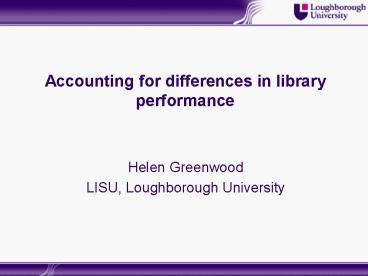Accounting for differences in library performance PowerPoint PPT Presentation
1 / 21
Title: Accounting for differences in library performance
1
Accounting for differences in library performance
- Helen Greenwood
- LISU, Loughborough University
2
Introduction
- Background
- Approach
- Key findings
- Ongoing work
3
Background to the study
- Library performance evaluation based on data
reported to CIPFA - Suspected inconsistency in the compilation of
data - Need to draw valid comparisons between similar
library services - Some authorities appear to be high spending but
low performing
4
Comparing apples to oranges?
- idiom used to indicate that two items or
groups of items have not been validly compared - (Wikipedia, 2007)
5
- I am aware of the criticisms from colleagues
within the profession that some of the data we
collect are no longer relevant and that some
collection methodologies leave much to be
desired (Lightfoot, 2003)
6
Numbers should be interpreted with care!
- Rseearch at Cmabrigde University shwos it desont
mttaer in what order the ltteers in a word are,
as long as the frist and lsat letters are in the
rghit palce - If only the same were true of numbers!
7
Approach
- For the study to be relevant and valuable in
practical terms it was necessary to identify
similar authorities - Based on
- - geographical factors
- - statistical benchmarking based on CIPFA data
8
Geographical factors
- Counties only
- Population distribution information was not
readily available so approach taken used the
ratio between population density of the two most
densely populated districts of each county - Where the most densely populated district was
more than nine times more densely populated than
the first, these counties were excluded
9
Statistical benchmarking
- Proportion of population aged under 15 and over
60 - Average population per service point
- Expenditure per capita
- Book stock per capita
- Total population, county area pop density
10
Nearest neighbour analysis
- Each measure was standardised across the counties
- ?
- Average distance from Leicestershire calculated
- ?
- Distances ranked and plotted
- ?
- Possible authorities identified
- ?
- Key output measures consulted
11
Distance from Leicestershire
12
Selecting the benchmarking group
Output measures considered to assist
decision-making
- issues (book AV)
- requests
- enquiries
- visits
- cost per visit
- population per professional staff
- staff expenditure
- materials expenditure
13
Accounting for differences in the data
- A working group of seven local authorities was
formed - Key areas were examined
- expenditure
- visitors
- premises
- stock
- transport
- staff
- services
- ICT
- income
14
Accounting for differences in the data
- How these data were compiled was discussed during
in-depth interviews - gt In groups individually
- gt Opportunity to talk openly about concerns with
the data seek important contextual info - Seminar focusing on visits, staff and ICT
expenditure data - gt Forum for the exchange of questions,
concerns approaches and ideas
15
Key findings
- Considerable variation in data collection,
compilation and reporting to CIPFA - Particular issue with catch-all categories e.g.
miscellaneous support services expenditure - Reasons for inconsistencies include
- gt Organisational differences
- gt Difficulties apportioning central costs
- gt Different accounting protocol
- gt Insufficient guidance from CIPFA
- gt Lack of respondents notes
- gt A desire to present favourable data!
16
Visits
- Definition of a visit
- Counting at events shared-use buildings
- Methods of counting
- e.g. Manual count 3.26M visits
- Automatic count 3.10M visits
- A difference of gt150,000, yet both methods are
acceptable - Calibration of people counters
- Views on reliability of figures
- Which figures reported to CIPFA
17
Staff costs
- Cost of central support
- Salary scales/grades/rates
- Overheads - part-time staff
- Training costs
- Contribution to wider objectives of the authority
18
ICT
- How ICT infrastructure is managed funded
- gt same type of expenditure found in three
different categories within the group! - Non-financial computing costs
- What provision includes
- Equipment replacement policy sustainability
- Measuring use of electronic services
19
Ongoing work
- Leicestershire and Warwickshire continuing to
work together - Staffing structures formulas
- Further examination of accounting procedures
- Adopted same approach to submitting data to
CIPFA - Reporting to Midlands Performance Group
20
Further information
- Anonymised report available to download
- www.lboro.ac.uk/depts/dis/lisu/pages/publications
- Nigel Thomas NThomas_at_leics.gov.uk
- Ayub Khan ayubkhan_at_warwickshire.gov.uk
21
(No Transcript)

